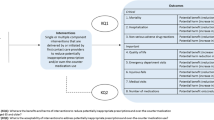Abstract
This paper traces the evolution of prescription-to-over-the-counter (OTC) switch criteria and assesses the impact of new developments in this and related areas, as a means to create a conceptual framework for considering the future of prescription-to-OTC switch. Over the past two decades, switch criteria have evolved from the foundational definitions of safety, effectiveness, and labeling in the OTC Review through the pharmacological interpretations of OTCness in Peck’s Principles, to the modern day focus in DeLap’s Principles on the consumer as the focal point for studying endpoints of self-care. Today’s switch criteria represent a solid regulatory/scientific foundation for the next evolution of OTC drugs: to treat chronic conditions and diseases, which are not being adequately treated with current health care options. Further dialogue on the potential for OTC access to enhance collaborative self-care should be actively considered.
Similar content being viewed by others
References
Soller RW. OTCness. Drug Inf J. 1997;32:555–560.
Woodcock J. Statement of Janet Woodcock, M.D., Director, Center for Drug Evaluation and Research, FDA for the Hearings on “Recent Developments Which May Impact Consumer Access to, and Demand for, Pharmaceuticals,” Subcommittee on Health, House Committee on Energy and Commerce, June 13, 2001.
21 CFR 330.10(a)(4)(i)(ii) and (v). 4.21 CFR 330.10(a)(4)(v).
Soller RW. The over-the-counter scientific/regulatory paradigm. Drug Inf J. 1999;33:799–804.
US Food and Drug Administration. Ibuprofen in people with mild kidney disease. Talk Paper. Rockville, MD: US Food and Drug Administration; May 2, 1990.
US Food and Drug Administration. Transcripts of joint meetings of the Nonprescription Drugs Advisory Committee and Endocrinologic and Metabolic Drugs Advisory Committee dated September 27, 1995, and May 13, 1997. Rockville, MD: US Food and Drug Administration; 1997.
US Food and Drug Administration. Regulations on statements made for dietary supplements concerning the effect of the product on the structure or function of the body; Final Rule. Federal Register. 2000;65:999–1050.
US Food and Drug Administration. OTC Treatment of Hypercholesterolemia Guidance for Industry. September 1997. http://www.fda.gov.
Consumer Healthcare Products Association. Written Comments Relating to the June 28–29, 2000 FDA Public Hearing on Over-the-Counter Drug Products. Docket No. OON-1256, submitted August 25, 2000. Washington, DC: Consumer Healthcare Products Association.
Titus S. E-mail to Open Hearing Requesters at the May 11, 2001 FDA Advisory Committee Meeting on Switching Second Generation Antihistamines. Docket No. 98P-0610, April 27, 2001.
Center for Drug Evaluation and Research Task Group on Risk Management. Managing the Risks From Medical Product Use: Creating a Risk Management Framework. Report to the Commissioner. Rockville, MD: US Food and Drug Administration, Center for Drug Evaluation and Research; May 1999.
Munger MA. Critical overview of antihypertensive therapies: what is preventing us from getting there? Am J Manag Care. 2000;6(Suppl):S211–21.
Joint National Committee on Prevention, Detection, Evaluation, and Treatment of High Blood Pressure. The Sixth Report of the Joint National Committee on Prevention, Detection, Evaluation, and Treatment of High Blood Pressure. NIH Publication No. 98-4080. Bethesda, MD: National Institutes of Health; November 1997.
Hoerger TJ, Bala MV, Bray JW, Wilcosky TC, Larosa J. Treatment patterns and distribution of low-density lipoprotein cholesterol levels in treatment-eligible United States adults. Am J Cardiology. 1998;82:61–65.
Lagace EA. Prevalence and severity of urinary incontinence in ambulatory adults: an UPRNet study. J FamPract. 1993;36(6):610–614.
Jones TV, Brunner SH. Approaches to urinary incontinence in a rural population: a comparison of physician assistants, nurse practitioners, and family physicians. J Am Board Fam Pract. 1998;3:207–215.
Author information
Authors and Affiliations
Corresponding author
Rights and permissions
About this article
Cite this article
Soller, R.W. Prescription-to-over-the-Counter Switch Criteria. Ther Innov Regul Sci 36, 309–317 (2002). https://doi.org/10.1177/009286150203600209
Published:
Issue Date:
DOI: https://doi.org/10.1177/009286150203600209




